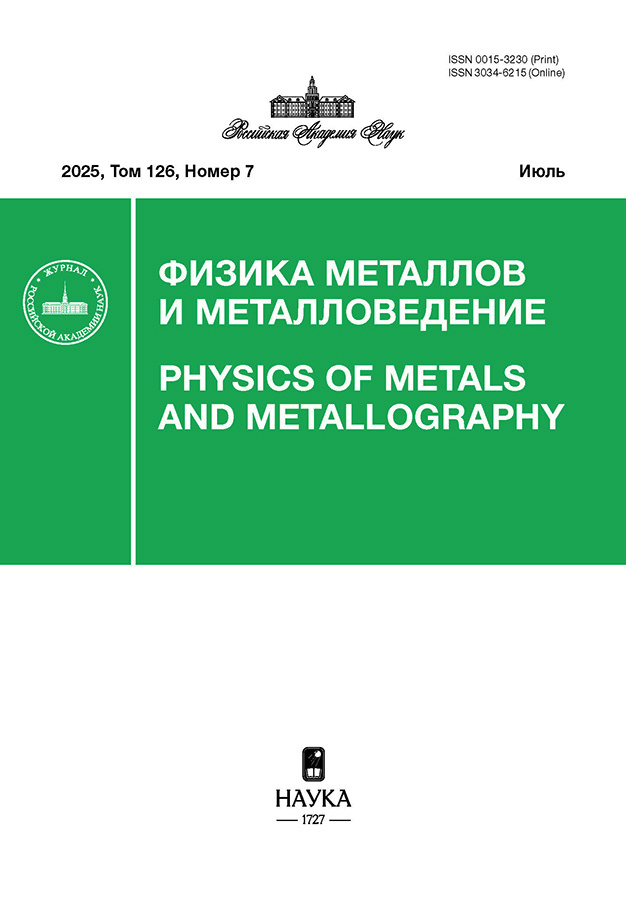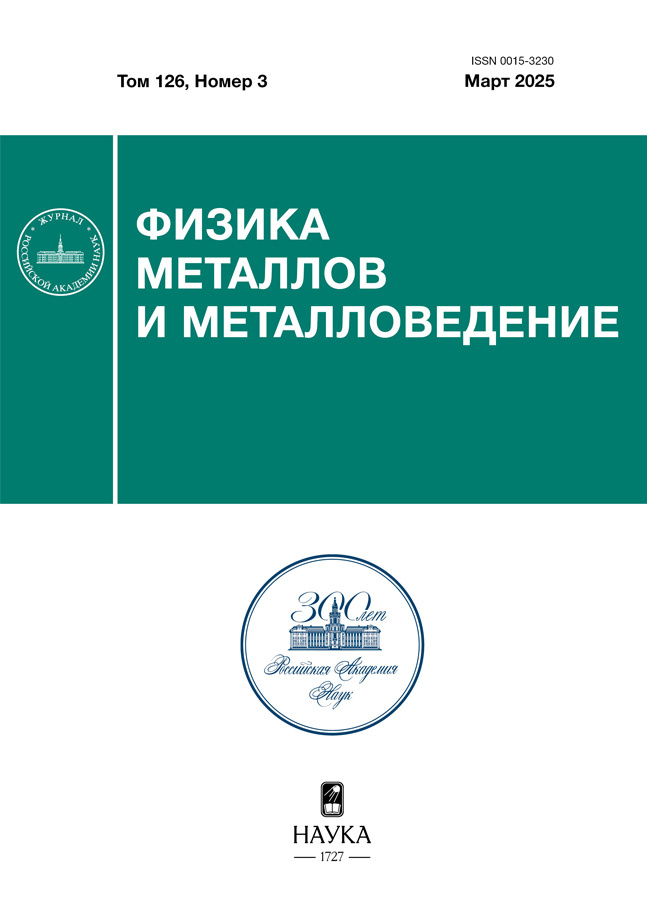Phase-field modeling of multiphase single-component system microstructure formation
- Authors: Korobeynikov S.A.1,2, Lebedev V.G.1, Lad'yanov V.I.1
-
Affiliations:
- Udmurt Federal Research Center, Ural Branch of the Russian Academy of Sciences
- Udmurt State University
- Issue: Vol 126, No 3 (2025)
- Pages: 328-341
- Section: СТРУКТУРА, ФАЗОВЫЕ ПРЕВРАЩЕНИЯ И ДИФФУЗИЯ
- URL: https://rjonco.com/0015-3230/article/view/686708
- DOI: https://doi.org/10.31857/S0015323025030094
- EDN: https://elibrary.ru/IMXKUG
- ID: 686708
Cite item
Abstract
The present study employs a phase-field description to consider the crystallisation process of one-component systems with microstructure formation. A closed physical and mathematical model of thermodynamically consistent relaxation equations for phase fields and heat conduction equations describing the interaction of different phases and crystallites of one phase with each other is obtained. The model incorporates latent heat of phase transition and is derived from the principle of entropy increase and enthalpy conservation law. A method of introducing phase-field fluctuations is proposed, with the aim of simulating homogeneous nucleation in the melt. The investigation of edge angle formation at the contact of three phases is undertaken on the basis of the obtained model. The crystallite size distribution obtained from the model is then compared with the theoretical Hillert distribution. The study goes on to examine the dependence of crystallite shape and size distribution on thermal gradient, and the influence of thermodynamic conditions on the process of polymorphic δ–γ transformation.
About the authors
S. A. Korobeynikov
Udmurt Federal Research Center, Ural Branch of the Russian Academy of Sciences; Udmurt State University
Author for correspondence.
Email: sa.korobeynikov@yandex.ru
Russian Federation, Izhevsk, 426067; Izhevsk, 426034
V. G. Lebedev
Udmurt Federal Research Center, Ural Branch of the Russian Academy of Sciences
Email: sa.korobeynikov@yandex.ru
Russian Federation, Izhevsk, 426067
V. I. Lad'yanov
Udmurt Federal Research Center, Ural Branch of the Russian Academy of Sciences
Email: sa.korobeynikov@yandex.ru
Russian Federation, Izhevsk, 426067
References
- Provatas N., Elder K. Phase-Field Methods in Materials Science and Engineering. John Wiley & Sons, Incorporated, 2010. 316 p.
- Boettinger W.J., Warren J.A., Beckermann C., Karma A. Phase-Field Simulation of Solidification // Annual Rev. Mater. Research. 2002. V. 32. No. 1. P. 163–194.
- Мейрманов А.М. Задача Стефана. М.: Наука, 1986. 240 c.
- Warren J.A., Boettinger W.J. Prediction of dendritic growth and microsegregation patterns in a binary alloy using the phase-field method // Acta Metal. Mater. 1995. V. 43. No. 2. P. 689–703.
- Kim S.G., Kim W.T., Suzuki T. Phase-field model for binary alloys // Phys. Rev. E. 1999. V. 60. № 6. P. 7186–7197.
- Pinomaa T., Provatas N. Quantitative phase field modeling of solute trapping and continuous growth kinetics in quasi-rapid solidification // Acta Mater. 2019. V. 168. No. 2. P. 167–177.
- Лебедев В.Г. Динамика перераспределения примеси на границах фаз растворов: фазово-полевой подход // Письма в ЖЭТФ. 2022. Т. 115. № 4. С. 256–261.
- Kobayashi R. Modeling and numerical simulations of dendritic crystal growth // Physica D. 1993. V. 63. № 3. P. 410–423.
- Steinbach I., Pezzolla F., Nestler B., Seeßelberg M., Prieler R., Schmitz G., Rezende J. A phase field concept for multiphase systems // Physica D: Nonlinear Phenomena. 1996. V. 94. No. 3. P. 135–147.
- Steinbach I., Pezzolla F. A generalized field method for multiphase transformations using interface fields // Physica D: Nonlinear Phenomena. 1999. V. 134. No. 4. P. 385–393.
- Eiken J., Böttger B., Steinbach I. Multiphase-field approach for multicomponent alloys with extrapolation scheme for numerical application // Phys. Rev. E. 2006. V. 73. No. 6. P. 066122.
- Dinsdale A. SGTE data for pure elements // Calphad. 1991. V. 15. No. 4. P. 317–425.
- Hillert M. Phase equilibria, phase diagrams and phase transformations: their thermodynamic basis. Cambridge University Press, 2009. 510 p.
- NIMS Materials Database (MatNavi) - DICE : National Institute for Materials Science — URL: https://mits.nims.go.jp/ (дата обр. 18.01.2025).
- Fan D., Chen L.-Q. Computer simulation of grain growth using a continuum field model // Acta Mater. 1997. V. 45. No. 2. P. 611–622.
- Львов П.Е., Светухин В.В. Влияние подвижности границ зерен на формирование вторых фаз в наноструктурированных бинарных сплавах // ФММ. 2022. Т. 123. № 10. С. 1072–078.
- Kessler D. Sharp interface limits of a thermodynamically consistent solutal phase field model // J. Cryst. Growth. 2001. V. 224. No. 1–2. P. 175–186.
- Groot S.R. de, Mazur P. Non-equilibrium thermodynamics. Dover Publications, 1984. 510 p.
- Kamachali R.D., Steinbach I. 3-D phase-field simulation of grain growth: Topological analysis versus mean-field approximations // Acta Mater. 2012. V. 60. No. 6/7. P. 2719–2728.
- Hillert M. On the theory of normal and abnormal grain growth // Acta Metal. 1965. V. 13. No. 3. P. 227–238.
- Лебедев В.Г., Лебедева А.А., Галенко П.К. О мезоскопическом описании локально-неравновесных процессов затвердевания чистых веществ // Письма в ЖЭТФ. 2015. Т. 101. № 2. С. 143–147.
- Wheeler A.A., Boettinger W.J., McFadden G.B. Phase-field model for isothermal phase transitions in binary alloys // Phys. Rev. A. 1992. V. 45. No. 10. P. 7424–7439.
- Perlin K. An image synthesizer // ACM SIGGRAPH Computer Graphics. 1985. V. 19. No. 3. P. 287–296.
- Eigen. URL: https://eigen.tuxfamily.org/index.php?title=Main_Page (дата обр. 13.11.2024).
- OpenCV. URL: https://opencv.org/ (дата обр. 13.11.2024).
- Rowlinson J.S., Widom B. Molecular theory of capillarity. Clarendon Pr., 1989. 327 p.
- Лейбензон В.А., Пилюшенко В.Л., Кондратенко В.М., Хрычиков В.Е., Недопекин Ф.В., Белоусов В.В., Дмитриев Ю.В. Затвердевание металлов и металлических композиций. Наукова думка, 2009. 404 c.
Supplementary files

















